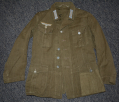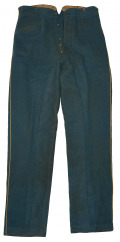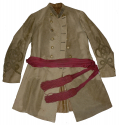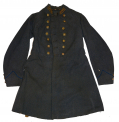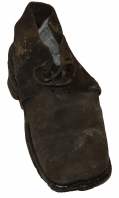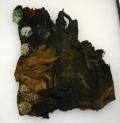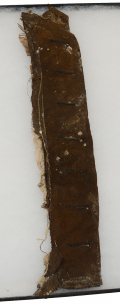site search
online catalog
Uniforms & Cloth
Showing 61 to 80 out of 191
5th NEW YORK NATIONAL GUARD COMPANY E FLANK MARKER
This very attractive blue silk marker with gold fringe and embroidered unit designation comes with a 1995 letter from flag authority Howard Madaus, a 2004 treatment report by Textile Preservation… (1179-014). Learn More »
WWII JAPANESE LEG WRAPS (PUTTEES)
Wraps and ties do not look to haven been shortened and there is a good amount of use war to them. There is a good bit of fraying on the edges of the wraps and the end of the ties. There is a white tag… (1235-258). Learn More »
WWII GERMAN AFRIKA CORPS TUNIC
Tunic shows little wear from use. There is an approx. 1 ½” tear in the lapel on the right side. One cuff button on the left side is missing. The collar tabs are machine sewn down and the eagle is… (1235-453). Learn More »
EXCELLENT CONDITION UNION ARTILLERY SHELL JACKET
Standard issue dark blue wool shell jacket with red piping on collar and cuffs with red trim down the front and along the edges. Jacket has 12 General Service eagle buttons down the front with two… (1179-160). Learn More »
WORLD CLASS IDENTIFIED WOUNDED IN ACTION CIVIL WAR NORTH CAROLINA SOLDIER’S JACKET WITH BULLET HOLE FROM HIS WOUND AT THE WILDERNESS!
Formerly in the collections of the Texas Civil War Museum this world-class Confederate infantryman’s jacket worn by William B. Royal came directly out of the family in 2002, having been previously… (814-69). Learn More »
MASSACHUSETTS HAVERSACK
These smaller white canvas haversacks fastening with two bone buttons usually show up marked with an ink stamp as “inspected and accepted” by Massachusetts. This one was most likely so marked as… (2024-1382). Learn More »
WWII GERMAN WINTER MITTENS
Mittens show little age and use wear. The string to hang them around your neck is still attached. The markings are on the white side and are a little blurry. The insides are feldrgrau [green grey]… (1235-152). Learn More »
EXCEEDINGLY RARE CIVIL WAR US CAVALRY TROUSERS
This is a wonderful pair of regulation Civil War US issue enlisted cavalryman’s trousers that are incredibly rare and in great condition. They are made of sky-blue kersey with waistband and pockets… (2024-1285). Learn More »
CONFEDERATE CAVALRY CAPTAIN’S FROCK COAT OF CAPT. EDWARD BIRD, “EFFINGHAM HUSSARS,” 2nd BATTALION AND 5th REGIMENT GEORGIA CAVALRY
This rare, identified, Confederate cavalry captain’s frock coat belonged to an officer who served from 1861 though 1865, rising from Captain to Colonel, with extensive action especially in… (1179-232). Learn More »
IDENTIFIED CONFEDERATE CAPTAIN’S FROCK COAT OF CAPTAIN PHARES WALDO SHEARER, 45th MISSISSIPPI, WITH 28-PAGE REMINSCENCES AND VETERAN’S BADGE- HE EXCHANGED SALUTES WITH THE WOUNDED JOHN BELL HOOD AT CHICKAMAUGA
This coat came directly out of the family along with a reunion badge and type-written copy of the officer’s 1906 reminiscences. The coat was formerly in the collection of Steve Mullinax, is… (1179-179). Learn More »
DOUBLE-DECAL WW2 LUFTWAFFE HELMET
Very good WW2 German luftwaffe helmet complete with liner and chinstrap. Better than 90 percent paint. Scratches to the national decal on the right as shown and rubbing to the eagle’s wingtips on… (169-685). Learn More »
$2,475.00
ON HOLD
CIVIL WAR-INDIAN WAR FORAGE CAP VISOR
This is a well preserved leather visor from a forage cap recovered at Fort Pembina, ND, where it was preserved in remarkable condition by wet, anaerobic soil conditions. This is typical of the simple… (1052-480). Learn More »
CIVIL WAR-INDIAN WAR FORAGE CAP VISOR
This is a well preserved leather visor from a forage cap recovered at Fort Pembina, ND, where it was preserved in remarkable condition by wet, anaerobic soil conditions. This is typical of the simple… (1052-483). Learn More »
FIRST WORLD WAR US M1917 HELMET WITH 78TH DIVISION INSIGNIA
This is a US made M1917 steel helmet used by a member of the 78th Infantry Division. Nearly identical to the British army helmet, the M1917 and later the M1917A1 were used up to the Second World War,… (490-6909). Learn More »
US NAVY SEAMAN’S DUFFEL BAG WITH EAGLE AND NAME
This seaman’s duffel bag, measuring about 23’ by 12 ½” when laid flat, was intended for personal clothing, etc., and has been personalized with a stenciled American eagle with outstretched… (1179-593). Learn More »
SCARCE CIVIL WAR ARMY ISSUE SHOE, A.K.A. BROGAN OR BOOTTEE
This Civil War US army issue shoe is typical wartime construction, using rough-side out black leather with reinforcing heel piece or “counter” sewn inside, four pairs of holes for a leather lace,… (1052-282). Learn More »
KNIT DRAWERS OR TROUSERS FROM FORT PEMBINA
These pieces are two legs from trousers or, more likely, drawers recovered in the excavations at Fort Pembina, ND, conducted on private property with the owner’s permission, where wet, anaerobic… (1052-446). Learn More »
CIVIL WAR-INDIAN WAR UNIFORM COAT PIECE WITH BUTTONS FROM FORT PEMBINA
This comes from the right lapel of a US army coat discarded by a soldier at Fort Pembina, ND, sometime between 1870 and 1895, and is from excavations in wet, anaerobic soil that has preserved leather… (1052-580). Learn More »
INDIAN WAR FIELD-USED CAMPAIGN HAT FROM FORT PEMBINA, NORTH DAKOTA
This is a real field-used Indian War campaign hat in relic condition excavated at Fort Pembina, ND, a small frontier army post in operation from 1870 to 1895. Anaerobic conditions of the dig have… (1052-253). Learn More »
US ARMY DRESS COAT LAPEL FROM FORT PEMBINA, ND
This coat lapel comes from the left side of US army dress coat discarded by a soldier at Fort Pembina, ND, and was excavated in wet, anaerobic soil that has preserved leather and cloth in remarkable… (1052-589). Learn More »
Showing 61 to 80 out of 191
Most Popular
Historical Firearms Stolen From The National Civil War Museum In Harrisburg, Pa »
Theft From Gravesite Of Gen. John Reynolds »
Selection Of Unframed Prints By Don Troiani »
Fine Condition Brass Infantry Bugle Insignia »
British Imported, Confederate Used Bayonet »
Scarce New Model 1865 Sharps Still In Percussion Near Factory New »
featured item
IDENTIFIED ISSUE RED BLANKET OF THEODORE P. BOWKER 13th MASSACHUSETTS - DIED OF WOUNDS AT ANTIETAM!
This is a rare, early-war, identified Massachusetts issue red blanket carried by a soldier in the 13th Massachusetts who was wounded at Antietam on Sept. 17, 1862, and died of those wounds at a U.S. hospital at Rappahannock Station on November 12.… (490-7138). Learn More »
site search
Upcoming Events
APRIL 12-13: SPRING GETTYSBURG MILITARY ANTIQUES SHOW; All Star Events Complex Learn More »





